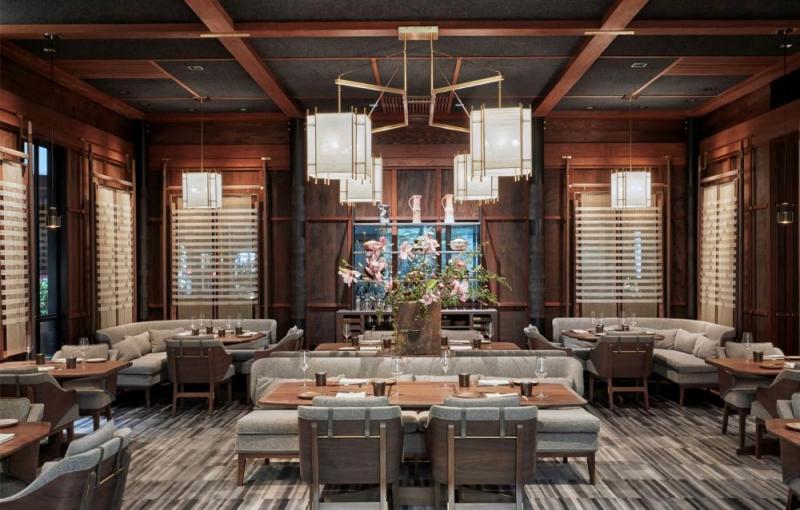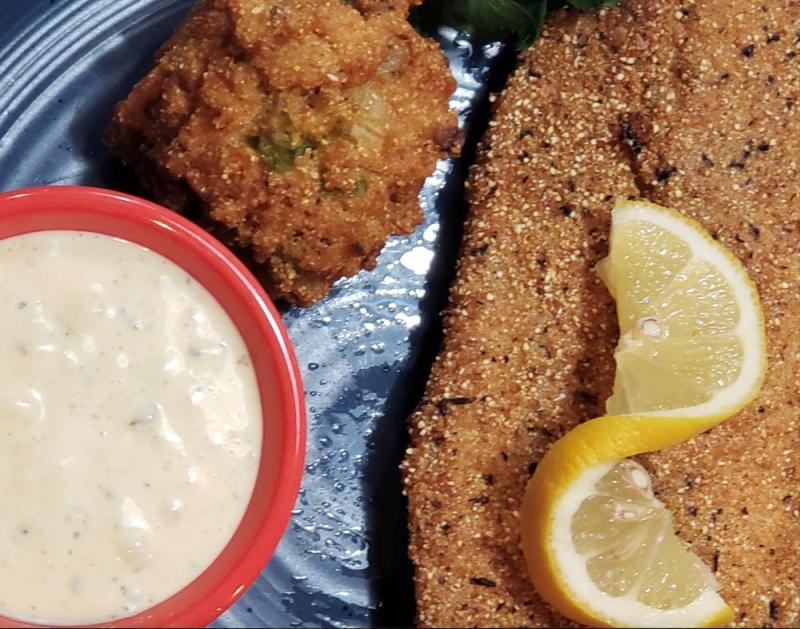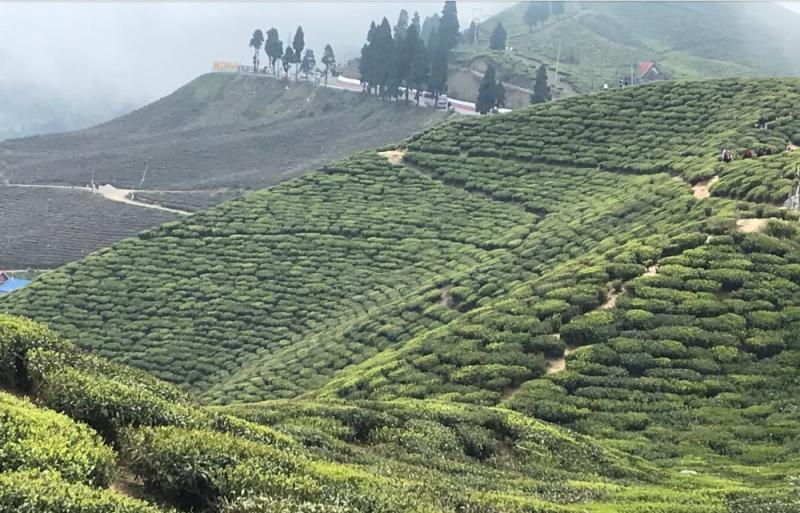In part four, we wrap up our series on the use of tea in restaurants by taking a look at the use of tea in culinary dishes. Miss an installment? Catch up on part one, tea as wine; part two, tea cocktails; and part three, tea pairings!
Beyond the cup, glass, or pairing, chefs are now embracing tea as a distinctive element in cooking in progressively imaginative ways.
Smoked lapsang souchong’s piney overtones might manifest in a reduction sauce for duck; matcha is increasingly used for savory applications; and floral teas like jasmine or osmanthus – less a tea than an Asian flower – may imbue broths or glazes.
On cooking, Kruze Coffee & Tea Owner and member of the International Tea Masters Association (ITMA) Stijn Van Schoonlandt says matcha is very popular: “I often see chefs using this in the dishes but not as a drink to go with the food, rather, as an ingredient.” He also has noticed that Earl Grey and smoked teas are used extensively.
The sheer range expressed by forms of tea in cooking offers chefs a wide selection of flavors—bitter, floral, earthy, grassy, smoky—that can’t easily be replicated with other ingredients. Its role in recipes aligns well with the broader trends of minimalism, mindfulness, and ingredient-driven cuisine.
At Japanese-inspired SingleThread Farm, Restaurant, Inn and Winery in Sonoma County, California, a Michelin three-star restaurant that pays homage to the intersection of Japanese and Californian culinary traditions, tea is used in both pairings and as infusions in seasonal dishes. With expertise from its winery, it sources and ages some of its own teas to achieve specific flavor profiles. Examples of Co-Owner/Chef Kyle Connaughton’s creations include an earthy pu-erh tea reduction used with duck and green tea oil in spring vegetables, bringing a brightness to them. For Connaughton, as with other ingredients, using tea is about “transferring energy from one living thing to another” – a concept that he finds quite humbling.

Concoctions from Sudha Kukreja, culinary consultant to Mayfair Manor, a luxury resort located at the scenic Jungpana Tea estate in Darjeeling, are less about subtlety as popularity, exemplified well by a snack that has become increasingly in demand among fans of Indian cuisine – tea pakoras. Kukreja describes how she makes them: “So, we take the tea leaves, and we batter, fry it, and then we make a chard out of it,” she describes. “We try to do it [paired] with the second flush [Darjeeling] tea.”
At high tea, Kukreja serves tea cakes baked at Mayfair Manor with matcha tea (though it isn’t grown on the estate) and one can even top it with their signature tea jelly.
Tea is used as a marinade at Mayfair Manor along with other seasonings and spices. “We [have] a whole chicken, which is marinated with various ingredients and wrapped in tea leaves,” Kukreja says. Once cooked, the chicken is then put on back the grill until the leaves smoke, which leaves a smoked glaze on top.
Kukreja also makes a kind of Chinese tea poached eggs (also known as “tea eggs”). “It’s not like the traditional poach,” she notes. “First the eggs are boiled just enough so the outer white gets cooked. Then they are cracked and steeped in tea, so the flavour of the tea is infused in the egg as it cooks further.” Soy sauce, salt, sugar, cinnamon, star anise and sugar are also typically used in this recipe, and the broth leaves a distinctive marble like pattern on the whites of the eggs.
Mayfair Manor uses fermented tea leaves in various dishes. “We ferment tea leaves in our kitchen, which is very tasty” says Kukreja. “We use fermented tea leaves to add flavor to soups and in chutneys.”
It’s a punchier approach than author, agronomist, tea expert, consultant, and owner of Lydia Gautier Natural Teas & Herbals (Thés &Tisanes Naturels), Lydia Gautier's recommendation of using green tea in a bouillon. “The vegetal quality of green tea adds character to the soup,” she says. Therein lies the difference between haute cuisine and other forms of culinary culture: it’s in the subtlety of the carefully considered preparations compared with the intensity of local cooking.
Local cooking is the emphasis of tea cultivators Jason McDonald and Timmy Gipson, along with author Virginia Utermohlen Lovelace. The trio collaborated on a cookbook when Covid-19 caused the tea plantation owned by The Great Mississippi Tea Company to shut down, temporarily. They’ve since published a variety of now popular tea-based recipes.
They use their own tea because of the unique sweet potato flavor that the teas naturally carry, which is suitable for the kinds of dishes chosen. Probably their most popular creations are their meat and seafood rubs.
“All of our teas kind of have a sweetness to them,” Gipson says. “And like with the beef, our black tea has kind of that almost sweet potato, ‘molassesy’ kind of flavor in it – and it lends really well to beef.”
Gipson adds, “So, it was pairing what we were getting out of each tea with the different protein that paired best with it.”

They found that the Black Magnolia tea goes well with beef, their Mississippi Belle Oolong tea was well suited for seafood and vegetables, their Mississippi Queen green tea worked best with pork, and The Great Mississippi Tea Company’s Mississippi Sunshine yellow tea combined well with poultry. Each rub features a melange of different seasonings and spices that complement not only the tea, but also the animal protein or vegetables.
Their collective intention was not to replicate what is being done in high-end restaurants. Rather, they wanted to take established dishes that were already popular in the southern United States, and add certain types of tea to them, whether in the form of ground leaves or steeped tea. They really wanted people to realize that tea can be used in novel ways to perk up dishes that have seen little innovation.
The recipes are compiled in The Great Mississippi Tea Company Cookbook, published in 2021, covering meals from breakfast waffles to main courses at dinner time. They’ve even done chutneys, which have become a hit – and which they sell separately along with the rubs at the small store called the Tea Shack, which they maintain at their plantation and on their website. From Sunshine yellow tea cheese balls to pimento deviled eggs, to Mississippi Queen (green tea) cold cucumber soup to salads and salad dressings with tea, to Mississippi Belle (oolong tea) fried catfish, it would take weeks to prepare and sample all the recipes. The theme they have kept is reasonably consistent: keep to what’s popular in the South, adding a tea-twist.
The cookbook even features baked goods. In fact, their raspberry thumbprint cookies are Gipson’s favorite. “I tried baking them, recently, without tea and found that they weren’t nearly as good. It’s the tea that really makes the difference!” he says.
What interested Gipson and McDonald in the cookbook project (aside from having the time during the Covid lockdown) was the fact that they’d seen nothing like it before. “We’d been to restaurants in big cities that used tea in menu items – but these were really more luxury establishments,” says Gipson, adding: “We didn’t really see anything out there for ordinary cooking – and thought that tea-based recipes should be more accessible. After all, not everyone can afford to go to a fancy restaurant for a meal – especially in this economy. But if they can prepare tea-based meals at home, then for many, there’s nothing better.”
Conclusion: An Emerging Tea Renaissance
Driven by health trends, cultural revival, and a desire for sensory sophistication in which alcohol is not necessarily a requirement, tea has become a symbol of refinement in the kitchen. Restaurants now curate tea programs as carefully as wine cellars—sourcing from small tea growers in Yunnan, Darjeeling, Uji, Taiwan – and even the United States.

The hiring of tea sommeliers, particularly in high-concept establishments, reflects this shift. These professionals are trained in the tea terroir of different regions, methods of processing, and food pairing—bringing the same care and precision traditionally observed in oenology (the study of wines).
Driven by consumer interest, the drive towards sustainability, and desire for creative flavor experiences, tea has come to represent culinary maturity at restaurants all over the world. As dining has evolved, tea is no longer just a warm cup at the end of a meal—it's a medium for connecting with nature, expressing emotions, savoring memories, and artisanal craft. Today’s culinary landscape sees acclaimed chefs and beverage directors, as well as ordinary folk with access to tea recipes, tapping into centuries of tea culture to craft experiences in a way that infuses the ancient with the avant-garde.
Plan to Attend or Participate in World Tea Expo, March 23-25, 2026
To learn about other key developments, trends, issues, hot topics and products within the global tea community, plan to attend World Tea Expo, March 23-25, 2026 in Las Vegas, co-located with Bar & Restaurant Expo. Visit WorldTeaExpo.com.
To book your sponsorship or exhibit space at World Tea Expo, or to inquire about advertising and sponsorship opportunities at World Tea News, contact:
Ellainy Karaboitis-Christopoulos, Business Development Manager, Questex
Phone: +1-212-895-8493; Email: [email protected]
Looking for professional tea education, certifications, and more? Visit World Tea Academy and register for courses today!
Also, be sure to stay connected with World Tea Expo on social media for details and insights about the event. Follow us on X, Facebook, Instagram and LinkedIn.
